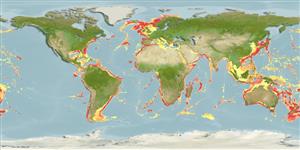分类 / Names
俗名 | 同种异名 | Catalog of Fishes(属, 种) | ITIS | CoL | WoRMS | Cloffa
Elasmobranchii
板鳃亚纲 (鲨鱼与 鱼) (sharks and rays) >
Squaliformes (Sleeper and dogfish sharks)
棘鮫目 (Sleeper and dogfish sharks) >
Dalatiidae (Sleeper sharks)
黑鮫科 (Sleeper sharks)
Etymology: Dalatias: Etymology not explained nor evident. A few online sources suggest Dalatias is derived from dalos (Gr.), torch or firebrand, but nothing in Rafinesque’s description supports this interpretation. Interestingly, D. licha is bioluminescent, a fact that was discovered and resported only recently and was certainly unknown to Rafinesque and other early naturalists. See: Mallefet J., D. W. Stevens, and L. Duchatelet. 2021. Bioluminescence of the largest luminous vertebrate, the kitefin shark, Dalatias licha: first insights and comparative aspects. Frontiers in Marine Science 8 (article 633582): 1-13 (See ETYFish); licha: Latinization of “La Liche” as reported by Broussonet (1780), an old French word for this shark, possibly from from the Occitan lecha or lec, meaning “glutton” (See ETYFish).
More on author: Bonnaterre.
Environment: milieu / climate zone / depth range / distribution range
生态学
海洋 深海底的; 深度上下限 37 - 1800 m (Ref. 247), usually 300 - 600 m (Ref. 247). 深水域; 72°N - 56°S, 98°W - 153°W
Western Atlantic: Georges Bank and northern Gulf of Mexico. Eastern Atlantic: Iceland (Ref. 12462), Scotland, and Irish Atlantic slope to Morocco, western Mediterranean, Madeira to Cameroon. Western Indian Ocean: Mozambique and South Africa. Western Pacific: Japan, Australia, and New Zealand. Central Pacific: Hawaii.
西大西洋: 新英格蘭喬治亞淺灘與墨西哥灣北部。 東大西洋: 冰島 (參考文獻 12462) ,蘇格蘭與愛爾蘭的大西洋斜坡到摩洛哥,地中海西部,馬得拉群島到喀麥隆。 西印度洋: 莫三比克與南非。 西太平洋: 日本,澳洲與紐西蘭。 中太平洋: 夏威夷。
Length at first maturity / 大小 / 重量 / 年龄
Maturity: Lm 139.0, range 117 - 159 cm
Max length : 182 cm TL 雄鱼/尚未辨别雌雄; (Ref. 10717)
背棘 (总数) : 0; 臀棘: 0. Moderately sized, short- and blunt-snouted shark with two almost equal-sized dorsal fins; papillose thick lips; small slender-cusped upper teeth and very large lower teeth with erect triangular serrated cusps and distal blades; first dorsal fin on back with its origin behind the pectoral rear tips and its base closer to the pectoral base than the pelvic fins; and caudal fin with the ventral lobe not expanded (Ref. 247). Dark grey-brown to black; trailing edges of fins translucent (Ref. 26346).
中等大小的, 短- 与吻钝的鲨鱼有二几乎相等的-大小了背鳍; 乳突状的厚唇; 小的尖端细的上颚齿与非常大的下颚齿有直立的三角形的锯齿状的尖头与末梢部的叶片; 第一背鳍背面有之上它的起点在胸的后顶端与它的基底后面更靠近超过腹鳍的胸鳍基底; 而且尾鳍有不被扩大的腹的叶.(参考文献 247) 暗灰褐色的到黑色的; 鳍的蔓缘半透明的.(参考文献 26346)
Found on outer continental and insular shelves and slopes (Ref. 247). Mainly found on or near the bottom but readily occurs well off the substrate (Ref. 247, 58302). Often pelagic (Ref. 58302). Found singly or in small schools (Ref. 6871). Feeds mainly on deepwater bony fish, but also skates, other sharks (etmopterids in Ref. 123656), cephalopods and crustaceans (Ref. 5578). This bioluminescent shark (currently the largest luminous vertebrate) emit light ventrally to counterilluminate which might be used to illuminate the ocean floor while searching/hunting for prey; or to stealthily approach prey, using counterillumination camouflage, before striking fast when it is close enough (Ref. 123656). Ovoviviparous (Ref. 205), with 10-20 young born at 30-42 cm (Ref. 26346). Used for its squalene liver oil, leather and meat, as well as for fishmeal (Ref. 6871).
栖息于大陆棚和岛屿棚外缘与斜坡了。 (参考文献 247) 主要地发现在底部上面或附近但是轻易地出现相当外海的底部.(参考文献 247) 发现独自或一小群.(参考文献 6871) 主要吃深水的硬骨鱼,也捕食魟鱼,其他的鲨鱼,头足类动物与甲壳动物。 (参考文献 5578) 卵胎生的 (参考文献 205), 藉由 10- 在 30-42 公分被出生的 20个幼鱼.(参考文献 26346) 用来了它的 squalene 肝油,皮革与肉, 以及用于鱼粉.(参考文献 6871)
Life cycle and mating behavior
成熟度 | 繁殖 | 产卵场 | 卵 | 孕卵数 | 仔鱼
Ovoviviparous (Ref. 247). 10-20 young born at 30-42 cm (Ref. 26346); 10-16 young born at 30 cm TL (Ref.58048). Distinct pairing with embrace (Ref. 205).西大西洋: 新英格蘭喬治亞淺灘與墨西哥灣北部。 東大西洋: 冰島 (參考文獻 12462) ,蘇格蘭與愛爾蘭的大西洋斜坡到摩洛哥,地中海西部,馬得拉群島到喀麥隆。 西印度洋: 莫三比克與南非。 西太平洋: 日本,澳洲與紐西蘭。 中太平洋: 夏威夷。
Compagno, L.J.V., 1984. FAO Species Catalogue. Vol. 4. Sharks of the world. An annotated and illustrated catalogue of shark species known to date. Part 1 - Hexanchiformes to Lamniformes. FAO Fish. Synop. 125(4/1):1-249. Rome, FAO. (Ref. 247)
世界自然保护联盟红皮书 (Ref. 130435: Version 2024-1)
人类利用
渔业: 低经济
工具
特别资料
下载 XML
网络资源
Estimates based on models
Preferred temperature (Ref.
123201): 2.5 - 14.3, mean 5.3 °C (based on 3093 cells).
Phylogenetic diversity index (Ref.
82804): PD
50 = 1.0020 [Uniqueness, from 0.5 = low to 2.0 = high].
Bayesian length-weight: a=0.00240 (0.00181 - 0.00318), b=3.14 (3.06 - 3.22), in cm total length, based on LWR estimates for this species (Ref.
93245).
营养阶层 (Ref.
69278): 4.2 ±0.4 se; based on diet studies.
回复力 (Ref.
120179): 低的, 最小族群倍增时间4.5 - 14 年 (Fec=10-20).
Prior r = 0.27, 95% CL = 0.18 - 0.40, Based on 1 data-limited stock assessment.
Fishing Vulnerability (Ref.
59153): High to very high vulnerability (65 of 100).
Climate Vulnerability (Ref.
125649): Moderate vulnerability (38 of 100).
Nutrients (Ref.
124155): Calcium = 6.01 [1.29, 31.29] mg/100g; Iron = 0.325 [0.075, 1.053] mg/100g; Protein = 19.3 [17.4, 21.2] %; Omega3 = 0.303 [0.107, 0.998] g/100g; Selenium = 21.6 [5.9, 65.2] μg/100g; VitaminA = 6.5 [1.4, 30.4] μg/100g; Zinc = 0.214 [0.104, 0.400] mg/100g (wet weight);
